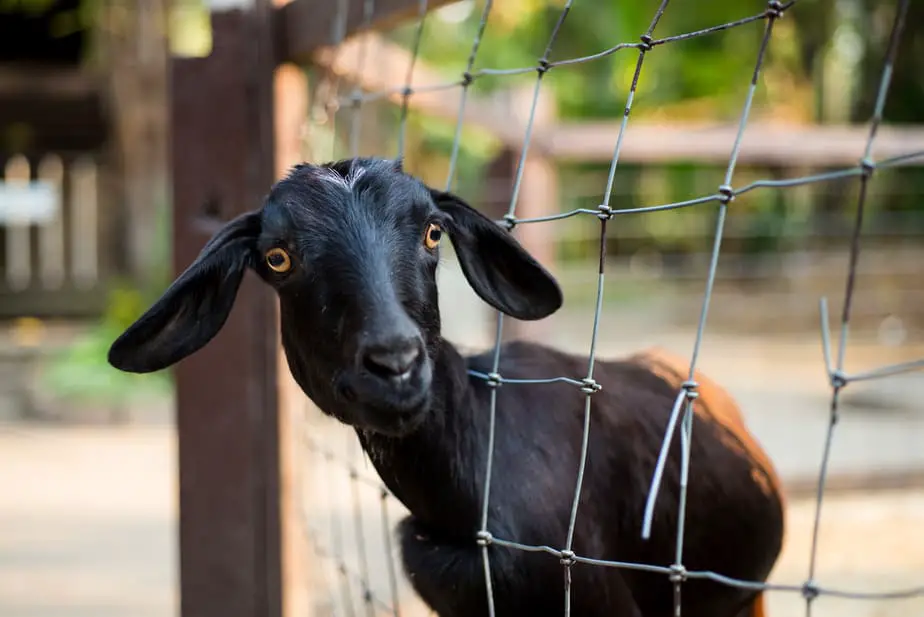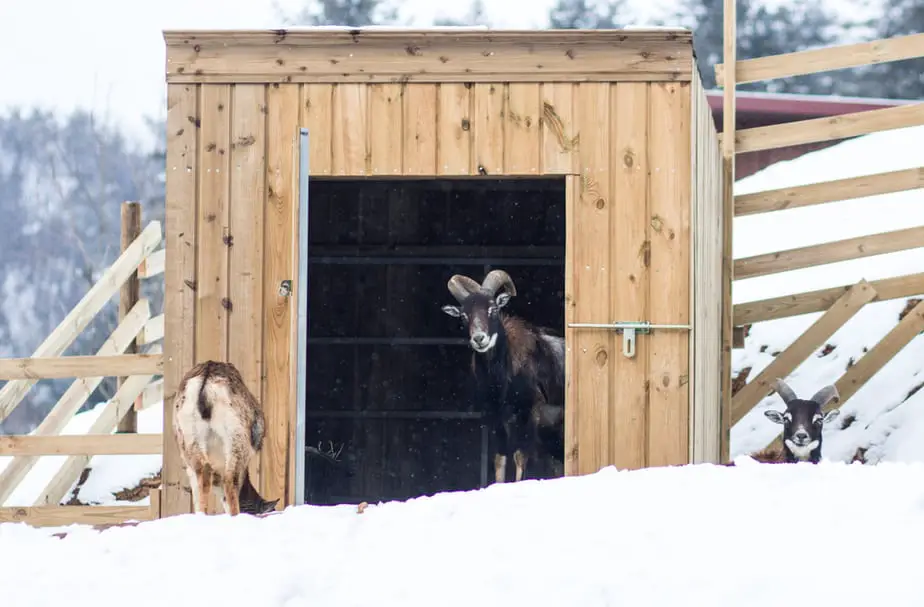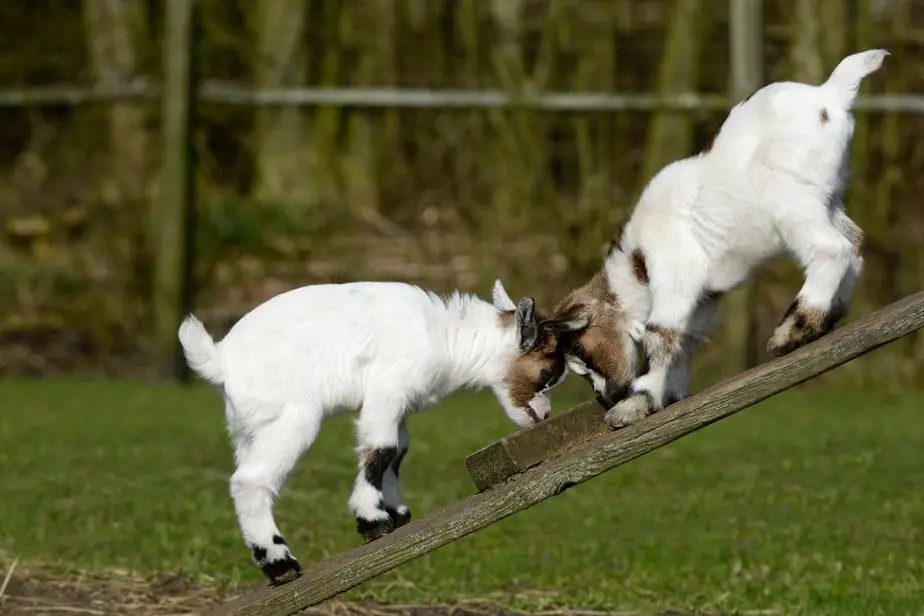Goats are adorable, funny, and curious animals that have stolen the hearts of pet owners everywhere. If you’ve been looking to by a goat or two, we have 10 steps in our “How to Care for Goats in your Backyard” guide to help you go about doing just that!

Let’s get started!
Table of Contents
Goat Knowledge
According to the Tractor Supply Goat Care Guide, “Goats are ruminants (They have four stomach compartments) meaning they are mammals that digest roughage by chewing, partially digesting, regurgitating and then chewing it some more.” According to Wikipedia, “Female goats are referred to as does or nannies, intact males are known as bucks or billies, and juvenile goats of both sexes are called kids. Castrated males are known as wethers. Life expectancy for goats is around 15 to 18 years.” Goats get lonely by themselves. If you want one goat, consider getting at least two.
There are many different breeds you can choose from.
Types of Goat Breeds:
- Dairy Goat Breeds, which are mainly used to produce milk.
- Fiber Goat Breeds, which are mainly used for the fibers to make clothes.
- Meat Goat Breeds, which are mainly used for, well, their meat.
- Brush Control Goat Breeds, which are mainly used to help clear brush on your land or farm.
- Pack Goat Breeds, in which the bucks or wethers are mainly used to carrying things. Does can be used for milk.
The information listed above is some things that we thought needed to be known about goats before purchasing them. Now that we know a little bit about goats let’s learn more in-depth about them in the first step.
Step 1: Research
Every responsible pet owner should start with research. They should know as much about the animal that they wish to bring to their home before getting the animal. This is the perfect time to check your local laws if you live in the city limits.
There are tons of great books about goats you can buy to read through and keep for use when you have another question about your goats. Maybe even go to your local library to check out a few books about goats and goat care. Maybe you have friends or family that have goats. Why not give them a call and talk to them about their experiences being goat owners?
Questions to answer during your research:
- What do you want to do with your goats? Do you want to milk them? Do you want them for pets?
- How do you milk goats? What can you use the goat milk for?
- How many goats do you want? Do you have enough space for that many goats?
- What kind of food will you provide your goats? What do you feel is best for your goats?
- Do you plan to breed your goats? You may want to get a doe and a buck if so.
- Used Book in Good Condition
- Weaver, Sue (Author)
- English (Publication Language)
- 224 Pages - 04/16/2011 (Publication Date) - Storey Publishing, LLC (Publisher)
Last update on 2025-03-28 / Affiliate links / Images from Amazon Product Advertising API
Healthy Goats:
- Weaning age: 3 to 5 months
- Gestation Period: 145- 153 days
- Goats have anywhere from 1 to 3 kids at a time. Twins are common.
- Playful and agile animals
- Alert and observant
- Friendly and adorable
Okay, the research is done. You know more about goats now than you could have ever imagined. That is great! Congratulations on completing the first step in our “How to Care for Goats in your Backyard” Guide. Now time to move onto the next step.
Step 2: Fencing

It’s very well known that goats are escape artists. They love to jump, explore, and escape. The goat fencing you choose will need to be built based on the number of goats you plan to have. They need enough room to run and play and the goat enclosure should have sun and shade, protection from wind, and no ornamental plants or grasses. You will, of course, either connect the goat fence to the goat house or you will put the goat fence around the goat house. Depending on the size of your goat house, they might try to jump on to of the roof so be sure to keep it away from the fence if it is small enough for that.
Step 3: Feed
Goats need access to pasture, hay, grain, and pellets. The majority of the food they consume should be roughage. Roughage includes shrubs and woody plants, and Forage such as hay and pasture. They will also need pellets and coarse-grain goat food. Hay such as alfalfa, Bermuda, or a blend. Pellets can be alfalfa, Bermuda, or a blend also. We encourage you to work with your veterinarian to ensure you are giving your goats everything they need.
There are feeders for goats that you may wish to buy or build. Be sure there is room for all your goats at the feeder. You may even want to put some feeders in the goat house. You can even build or buy hay feeders that will help save hay from being tossed on the ground and trampled on.
Aside from the feed goats should get, there are quite a few things they shouldn’t get, as well.
Poisonous Plants for Goats:
- Azaleas
- Hemlock
- Wild Cherry
- Members of the laurel family
- And many more
Step 4: Water
Goats, like all animals, need water. There are water troughs that work great for goats. Be sure that you have enough water troughs so that all your goats can fit around them at once. You may even want to put some smaller troughs in the goat house.
Step 5: Housing

Goats need housing to protect them from wind, snow and rain. It’s also a good idea to put bedding in their housing. The housing size will depend on the number of goats you decide to have. Make sure each of your goats can fit comfortably inside all at once.
Each adult standard sized goat needs about 10 to 15 square feet. Remember they love to climb so if your goat house is small enough for them to jump on top, keep it away from the fence so they do not escape.
Step 6: Minerals and Baking Soda
Goats need minerals, which usually come in the form of block minerals and loose minerals. Goats also need baking soda, which helps them with bloating. Ph in goats rumen can get off balance, and when it does, the goats will know when they need their minerals, so just leave it out for free choice.
It’s a good idea to have both minerals and baking soda in the goat house alongside the feeder and water trough. If it’s rainy and stormy they will still get hungry and thirsty. So have two or more of the minerals and baking soda feeders, along with the feeders and water troughs indoors at all times.
Step 7: Dewormer
Like any pet, goats need to be wormed about every six months. You can find dewormers at your local feed store or get in contact with your vet about what they think the best option is to keep your goats happy, healthy, and parasite-free.
Step 8: Hoof Trimmers
Goats need their hooves checked every couple of months to make sure they do not need to be trimmed. If they do then go ahead and trim them yourself or find someone who can trim them for you. Tractor Supplies’ Guide on trimming your goat’s hooves, by Suzanne Gasparotto says, “Out-of-shape and overgrown hooves can lead to illness, and even death, in goats.” No one wants that for their beloved goats. Be sure to check their hooves often to make sure they are looking nice and healthy.
Supplies needed:
- Hoof Trimmers
- Hoof Dressing
- Bleed Control
- Hand-held electric grinder
Step 9: Entertainment for Your Goats

Goats are fun to watch just on their own. But how much more fun would they be to watch if they had structures to climb on or things to play with?
Structure Ideas:
- Straw bales stacked up. Safely stack straw bales on top of each other so that it looks like steps going to the top.
- Picnic Tables. If you find an old picnic table grab it and put it in your goat enclosure.
- Custom-built platforms. Grab some scrap wood and see what you can build for your goats to climb on.
- Cable Spools. They are perfect for goats to jump on and play around.
Remember goats love to jump or climb. They might easily jump over a fence if you put the structures too close to the fence. Keep the play structures towards the middle of your goat enclosure.
If you live somewhere with little room to play be sure you leash train your goats and take them on a walk daily so they can get some exercise.
Step 10: Picking out your Goats
Remember you need to get two or more. You don’t want your goat to get lonely. That is very important to remember when choosing which goats to add to your family. Also, go back to your research questions, think about whether you want goats as pets or goats to milk.
It’s probably a good idea to search for goats that were dis-budded as kids. Meaning they can not develop horns to fight or hurt each other.
When you go to pick up your new goats be sure to check where they come from. Make sure they have had plenty of room, clean and dry living spaces, and that their living area is not overcrowded. If you find somewhere that has all these things then your goat will most likely be healthy. You may want to get them checked by your local veterinarian, just to make sure your new goats are healthy. The veterinarian may say you need to vaccinate them as well.
Lastly, be sure that your new goats like to be fed and touched by humans and that they aren’t terrified when you approach them. This will ensure that you can form bonds with your new goats.
Conclusion
We hope you have enjoyed our “How to Care for Goats in your Backyard” Guide. Each step is very important. If you do not already own goats then try to prepare and learn as much as you can before finding your adorable goats. Hopefully, our guide will help you through the process!
We hope you truly enjoy your new goat friends!
